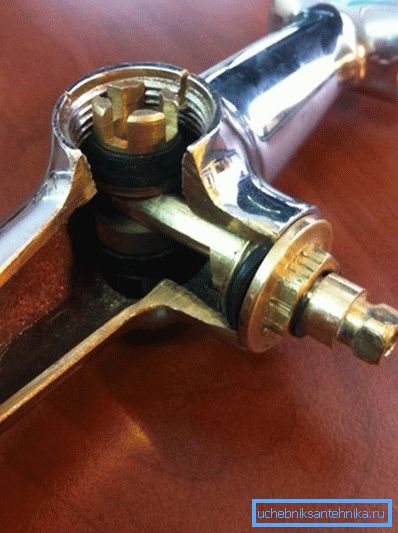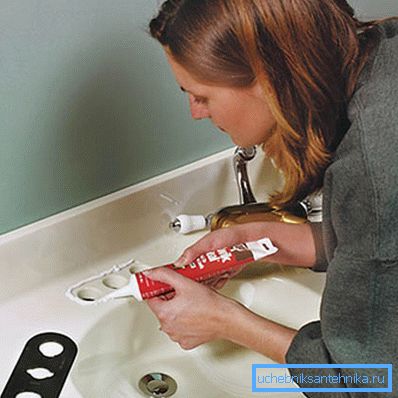Sink faucet: useful information
The sink faucet in the bathroom determines the level of overall comfort of the bathroom, and is also a prominent part of the interior room. For this reason, the selection and installation of this sanitary device is better to treat as responsibly as possible. And we, for our part, will advise you how to pick up and install the faucet on the sink in the bathroom.

Mixing taps for water
Purpose and principle of action

Modern housing is difficult to imagine without the basic amenities, the central place among which is the supply of hot and cold water to the apartment.
Even if hot water is not supplied, a gas water heater or an electric boiler is installed in the house to heat it. In short, even in the most modest dwellings there is a cold and hot water supply.

In this case, the temperature of the water that is served as hot is usually quite high. This is explained by the fact that it is much easier to lower its temperature, if necessary, than to raise it.
Cold water, on the contrary, has a sufficiently low temperature, since the pipes are laid under the ground and retain the cool state of the transported fluid, only in the room can the water be heated during prolonged stagnation in the riser. However, when you open the tap, after a few seconds you will feel how the water turned cold again.
So, we see that there are two streams with extreme temperatures - very cold and very warm. How do we get something in between?

Note! For these purposes, faucets for the sink in the bathroom, which allow the production of cold water in the warm to lower its temperature to a comfortable value, are used. This is the main purpose of any mixing tap.
Device

The taps for mixing water of different temperatures are very simple: the brass body has two holes at the bottom for water connections. From these openings go channels that pass through a special device - crane-axle box.
The design of these devices allows you to gradually block the channels and reduce the flow of water, or even block it.

Next, the channels merge into one common flow, which is directed to the upper part of the body. Here there is a hole in which a so-called “gander” is mounted - a tube of such a shape, at which the water jet acquires the most convenient shape and falls exactly into the bowl of the sink.
There are models of cranes with separate cranes for each channel, they are called two-valve. In addition, products in which both channels overlap with a common mechanism enclosed in a special cartridge have become very popular.

Finally, there are products equipped with automatic mixers based on three-way valves with a ball and other adjustment mechanism. Such models appeared relatively recently and only began to gain popularity. They are distinguished by an increased level of convenience and high price.

Note! Sometimes there is an unusual option for our seats: a sink with two mixers. This configuration is justified only if both faucets are connected to hot and cold water and allow two people to use the sink at the same time. If one faucet supplies hot water, and the second cold - this is a useless design.
Most often, mixing devices are installed on the sink. If for some reason it is decided to fix the tap on the wall, a cap for the sink instead of a faucet is inserted into the hole in the bowl.
What you need to know about the technical features

Now let's talk about those points that you should know and take into account when choosing a device. The first important feature is the material that makes up the mixer.
Currently there are several options available:
- Brass products. This is the most common and quite qualitative option for the production of which sanitary brass is used - an alloy of copper, chromium, lead and a special complex of additives that increase the operational, chemical and physical qualities of the material. Most quality cranes from leading manufacturers are made of brass;
- Bronze taps. They are also distinguished by high quality, reliability and durability, however, the cost of bronze is much higher than brass, therefore this material is typical for VIP-class models along with silver, gold and other precious metals;
- Aluminum alloy products. For the manufacture of the cheapest or counterfeit lots, aluminum-silicon alloy called silumin is often used. This is the lowest quality and unacceptable option, the service life of which rarely exceeds 2 - 3 years, and sometimes such products break even during the installation phase;
- Stainless steel faucets can be found.. This material is much more expensive than brass in production, so it is rarely used. Constructions from ordinary steel are not applicable.

Note! When buying a tap, choose brass products. It is simple to distinguish them: they are much heavier than aluminum, they have a yellow color under a layer of nickel.
An equally important detail is the type of valves used. Most modern mixers are equipped with crane boxes or mixing cartridges with ceramic plates, which are characterized by high tightness, smooth running and quiet operation.
However, there are also outdated models, where worm-boxes with rubber gaskets are used as valves.

Such devices are much more likely to flow, eventually begin to make noise or whistle when opening and require periodic replacement of gaskets, which wear out quickly enough. In addition, for the full opening of the channel it is necessary to make a few turns of the valve.
Note! Buy faucets equipped with only ceramic faucets. The only condition for their smooth operation is the presence of a coarse water filter.

One more important detail is flexible hoses for water supply from main pipes. They must be made of non-toxic ethyl propylene rubber (EPDM) and be braided in stainless steel or polymer fiber.
It is strongly not recommended to buy liners from technical rubber with a silumin or iron braid.

Note! Sinks and faucets for the kitchen are selected on the same principle.
Installation

Now our traditional installation manual for those who intend to install the mixer with their own hands:
- We take the product out of the box and collect in accordance with the recommendations of the manufacturer. Connect the flexible hose fittings and insert the device into the mounting hole on the sink, pre-threading the hoses;

- When installing, we forget to put a rubber seal between the sink and the body of the product;

- On the reverse side we screw the fastening nut. If the fixation is different - we twist the pins, put on the bracket and press it with nuts. The tap must stand firmly in the bowl;

- Connect the hoses with the other ends to the pipes with the help of cap nuts. We wind them with our hands up to the stop, then we tighten the key with a half turn, with a maximum of 270 ?.

- Turn on the water supply and test the system. We examine the connections of the hoses, as well as the connection of the body to the bowl, if drops and puddles appear, we reach them.

Note! When fastening structures to ceramic bowls, you should very carefully tighten the nuts, otherwise the sink may burst.
Conclusion
The choice of the mixer should be taken as responsibly as possible: low-quality goods will not only deprive you of the pleasure of using a comfortable bathroom, but also add the risk of flooding.
Installation and installation can be made by own forces on condition of performance of the instruction. To better remember what you read, watch the video in this article.